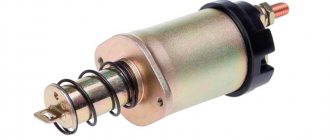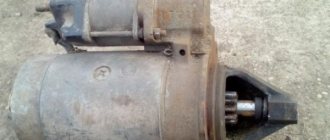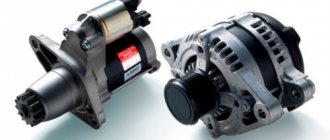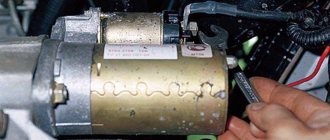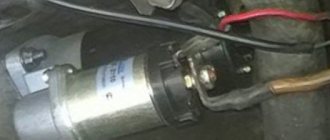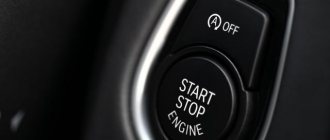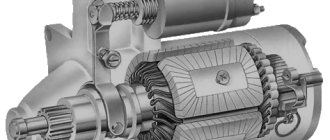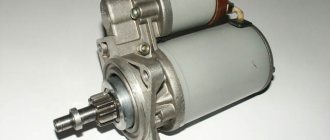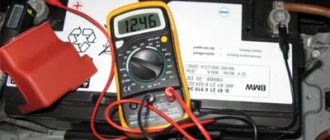The main part of the car engine starting system is the starter. Few vehicle owners know that this element has several types of design, one of the most common is the gear starter. This is a rather complex device, thanks to which it is possible to start the power unit efficiently and as quickly as possible due to the smooth increase in speed of its crankshaft. It is noteworthy that this design of the starter has increased power and service life. Moreover, its weight and size are much smaller than the standard design.
Gear starter
This is a device for autostarting the internal combustion engine of a car with a built-in gearbox. Any gearbox serves to change the rotation speed and facilitate the operation of the drive shaft. In the case of such a starter, the gearbox greatly facilitates the rotation of the starter shaft. Therefore, the component parts and overall dimensions themselves are much smaller than those of a starter without a gearbox.
The gearbox is installed between the armature and the bendix. The anchor rotates the gearbox mechanisms, and they rotate the bendix, which engages with the flywheel of the internal combustion engine crankshaft and transmits rotational motion to it.
Advantages of planetary devices
Compared to traditional gearboxes, we can highlight the following advantages that this device has: they can create huge speed ratios with a low number of gears. The gears of the mechanism are small in size due to their number. Thus, one more massive wheel distributes the load evenly across several satellites. It follows from this that the device is not very large and bulky. However, calculations and practice show that at high gear ratios, performance and efficiency are greatly reduced. And as a conclusion of all of the above, the main advantages are:
Such advantages also require appropriate manufacturing. Starting from calculation, design and ending with manufacturing - everything must be precisely accurate. These gearboxes have found a very wide range of applications in various industries: instrument making, machine tool manufacturing, mechanical engineering, etc. In this article we will dwell in more detail on the use of this device in the mechanical engineering industry.
Gear starter device
The main parts of the mechanism are the same as in a regular car starter, only there is also a gearbox.
The starter structure consists of:
- anchor;
- bendix;
- mask;
- solenoid relay;
- gearbox;
- stator;
- sleeve;
- fork.
Although the main parts are the same, they are located differently. The Bendix in the gear starter sits on its shaft. This design and the presence of a gearbox make it easier to start when the car battery is low.
The efficiency of a gear starter is 1.5 times greater than the efficiency without a gear starter.
Operating principle of a gear starter:
- The current is supplied by the relay.
- The anchor is retracted.
- Bendix is thrown out.
- The pin contacts are closed and voltage is applied directly to them.
- The armature rotates and transmits the rotational force to the gears of the gearbox, which rotates the bendix.
- Bendix is directly engaged with the flywheels of the car engine and rotates it.
- The engine starts.
Classic starter: operating principle and design
The key feature of such a device is that there is no such intermediate unit as a gearbox. This allows rotation to be transmitted directly from the starter to the crankshaft. Consequently, the device is simpler to manufacture and much easier to repair. Another feature of such a starter is that the electric current supplied to the switch allows you to instantly engage the gear and flywheel. This helps the car to start, as drivers say, in a snap.
Currently, they are trying to replace such starters with reduction ones. However, most cars used to have a classic starter. The operating principle and design made this unit extremely durable. Such units almost never fail due to electrical influence, but much more often they need to be repaired due to low temperatures.
Differences from a conventional starter
As already noted, the main difference is the presence of a gearbox and the location of the bendix.
There are modernized gear starters. They do not have an interacting section with splines. Many parts in the new modernized starter with gearbox are plastic. Due to this, the weight is not large and the price is lower. These starters are not repairable, that is, they cannot be repaired. A gear starter requires much less current to activate and operate. This helps when the car battery discharges quickly, for example, in severe frosts.
Starter with planetary gear
A starter is a device in the car's starting system that spins the engine crankshaft to the speed required for starting.
Work in the field of improving electric motors has made it possible to create a simple and fairly lightweight design of a starter with excitation by permanent magnets and with reduction gear.
The figure shows the armature and reduction gear of the Bosch DW starter. The reduction gear is a planetary gear set, the sun (central) gear of which is fixed to the armature shaft, and the output power is removed from the carrier, on the axes of which freely rotating satellites are installed. The planetary gears with external teeth are made of steel, and the epicyclic gear (with internal teeth) is made of a polyamide compound with mineral additives or powder metallurgy to increase wear resistance.
Rice. Starter electric motor with reduction gear: 1 – planetary gear carrier shaft with oblique splines; 2 – epicycle of planetary gear; 3 – satellites; 4 – sun gear mounted on the shaft; 5 – anchor; 6 – collector
The figure shows a schematic design of the starter.
Rice. Bosch DW starter diagram with permanent magnets and reduction gear: 1 – gear; 2 – flywheel crown; 3 – overrunning clutch; 4 – control lever; 5 – planetary gear; 6 – permanent magnet; 7 – anchor; 8 – collector with graphite brushes; 9 – electromagnetic drive with retracting and holding windings; 10 – starter switch; 11 – battery
The satellites, pressed from powder, rotate on axes in plain bearings or needle bearings. The latter are preferable, as they provide greater gearbox efficiency. The satellite axis is also the inner race of the needle bearing. This places high demands on the material and precision of the axes. The central gear is made integral with the armature shaft or can be removable. To obtain minimal mechanical losses and ensure a high service life, increased demands are placed on the precision of manufacturing gears and other gearbox parts. High-quality lubricants are used for the same purpose. The gear ratio is usually 3…5.
The starter armature with gearbox has design features. The armature winding is impregnated with a compound that reduces the likelihood of it being carried away. Due to the increased rotation speed, the armature must undergo dynamic balancing. To reduce losses due to hysteresis and eddy currents, the armature package is assembled from thin-sheet (0.5 mm thick) electrical steel plates.
Due to the reduced metal consumption and increased power density, starters with gearboxes have higher thermal stress compared to starters without gearboxes.
The most important part in starters with a gearbox is the brush-commutator assembly. The current density under the brushes in maximum power mode is 1.5...2.5 times higher than the current density of conventional starters. In such conditions, the use of special brushes with a high graphite content on the running edge is required. This increases the resistance of the switched circuit and improves switching. In addition, the brushes are shifted against the direction of rotation by 0.3...0.5 commutator divisions. As a result, the wear rate of brushes and commutator is reduced to the level of starters without gearboxes.
The magnets used are permanent magnets made of strontium ferrite, which have an increased coercivity compared to magnets made of barium ferrite. The increased coercive force increases the resistance of the magnets against demagnetization by the armature reaction at the moment the starter is turned on when the short circuit current is applied. To increase resistance to demagnetization, special treatment of the running section of the magnet is used, leading to an additional local increase in the coercive force, and the number of poles is also increased.
This starter is 40% lighter than a conventional starter and is designed for use with engines up to 5 liters in volume.
Source
Starter with gearbox
The parameter that determines the rational coordination of the power characteristics of the electric starting device with the starting characteristics of the internal combustion engine is the gear ratio /df of the drive from the starter to the engine. This parameter affects the angle of inclination of the mechanical characteristics of the starter motor related to the crankshaft of the internal combustion engine. For each engine and given starting conditions, there are optimal gear ratios at which the power characteristics of the starting device are best used. However, with gearless
transmission, the gear ratio /dc can be no more than 16, which is limited by the conditions of the mechanical strength of the starter drive gear.
On the other hand, increasing the gear ratio makes it possible to reduce the size and, accordingly, the weight of the starter motor, since these parameters change in inverse proportion to the shaft speed. In recent years, one of the main directions for improving starting systems has been to reduce the mass of active materials, the cost of which is about 50% of the cost of the starter. At the same time, in addition to using such well-known methods as replacing copper winding wires with lighter aluminum ones and reducing dimensions through the use of insulation of a higher heat resistance class, high-speed, small-sized starter electric motors with a built-in gearbox have become increasingly used.
In Fig. Figure 2.20 shows, as an example, the dependence of the mass of active materials m on the calculated rated rotational speed of the rotor of a 1.4 kW starter motor. The total mass of the starter vehicle depends on its rated power Рс (Fig. 2.21). In this case, the advantages of starters with gearboxes appear starting from a power of approximately 1 kW. For low-power starters installed on carburetor internal combustion engines with a small displacement, the use of a gearbox does not reduce the total weight of the vehicle. For them, it is advisable to use direct drive.
Advantages and disadvantages
Like any other device, a starter with a gearbox has not only advantages, but also disadvantages.
Pros:
- Long service life.
- Low energy consumption.
- Small dimensions and less weight.
- Low price.
Minuses:
- Repair is more difficult, if possible.
- Weakness of the design. It has a certain power limit, so it is better not to install gear starters on trucks.
Such starters with gearboxes are especially effective in areas with cold climates.
Advantages and disadvantages of the design
A gear starter is considered a more advanced and reliable version of the device. However, if the mechanism had no shortcomings, the use of this type of starter would be much more widespread.
Important advantages include:
- fastest engine start even at low temperatures;
- low energy consumption;
- compact dimensions and light weight.
Along with the advantages, the gear starter has its disadvantages:
- difficulty of repair (often the mechanism only needs to be replaced);
- weakness of the design (to reduce weight, plastic parts are used that can withstand the load only to certain limits).
Gear starter repair
A gearbox failure will cost approximately the same as a new gearbox. Other starter parts can be changed one by one.
And in this photo you can see how the gears of the gearbox wear out, and how many chips accumulate and how the lubricant becomes coked over time.
Reducer gears.
Frequent breakdowns of a starter with gearbox:
- When turning the ignition key, the starter does not operate. The reason for the starter itself not responding is in the pin contacts of the solenoid relay. Also, it often happens that the battery terminals are loose and fire every other time.
- Sometimes there are problems starting the internal combustion engine when the starter is working properly. In this case, the starter works, but there may be a breakdown in the bendix or gearbox.
- Sometimes there are problems with starting a car engine when the solenoid relay is working properly. The reason is most likely in the starter and armature windings.
If you don’t have experience at least monitoring the repair of the starter, you can only disassemble and check the parts for integrity. Let an auto electrician check the winding.
Starter operation stages
This node works as follows:
- connection of the gear to the flywheel;
- starting the starter;
- disconnecting the gear and flywheel.
Naturally, the starter only works when the engine starts, and then turns off. If this does not happen, then one of the mechanisms is faulty.
After the driver inserts the key into the ignition and turns it to the operating position, current is supplied from the battery to the traction relay. Thanks to this, the bendix of the gear starter engages the gears, at the same time, due to the supply of voltage to the electric motor, the circuit is closed and the car starts. Once the engine speed exceeds the speed of our starter, it turns off. It turns on only the next time the engine is started. Well, now let's look at how a gear starter differs from a regular one. There are some interesting details here.
Video
How to replace a gear starter with your own hands.
How to start a car at -30 degrees with a gear starter.
Tips: which gear starter is better to choose for the OKA, OKA 2 machine.
How to check the performance of the starter using the battery.
This video shows the process of repairing the starter.
For those who want to tinker, there is an opportunity to improve the gear starter.
0
Author of the publication
offline 1 week
Description and principle of operation:
Planetary gearboxes have a number of common features with spur gearboxes, since force transmission also occurs through a gear drive, and gears are used in the design. However, the design of planetary gearboxes, as well as the operating principle, is more complex.
In general, the following main parts can be distinguished in a planetary gearbox: ring gear, planetary gears (satellites), carrier and sun gear. By analogy with the Sun, located in the center of the solar system, the sun gear is located in the center of the working part of the gearbox. It meshes with identical planetary gears, the axes of which are located on a circle, the center of which lies on the axis of the sun gear, and at the same time the planet gears are engaged with the ring gear, which is an internal gear. The carrier rigidly secures all the satellites relative to each other.
For a planetary gearbox to operate, it is necessary that one of its parts (sun gear, ring gear or carrier) be rigidly attached to the gearbox housing. Depending on the choice of the driving and driven elements, the gear ratio of the planetary gearbox will depend. Also, the operation of a planetary gearbox is possible even when none of its parts are secured. In this case, it becomes possible to decompose one movement into two (for example, from the sun gear to the ring gear and carrier), or to merge two movements into one.
